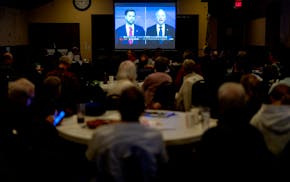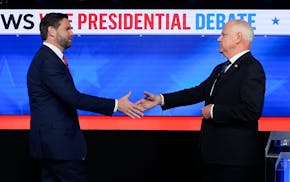Minnesota Democrats control the state House by six seats out of 134 legislators on the ballot this fall.
That narrow margin is all that stands between all-DFL-controlled government in the state and Republicans gaining back a foothold in state politics this election year. Republicans only need to pick up four seats to take control, making the battle to control the state House one of the most-watched contests on the ballot in Minnesota this fall.
Ultimately only a handful of the House seats will be competitive, attracting millions of dollars in spending from candidates, parties and outside political groups trying to tip the balance of power. Here are five early dynamics to watch in the race for the state House, from geography and money to messaging:
Republicans could win the House back in greater Minnesota.
The fight to control the chamber could be determined in a handful of seats outside of the metro area where Republicans see an opening. One of their top targets recently got more competitive when Rep. Dave Lislegard, DFL-Aurora, announced his retirement after the session adjourned. The former Iron Range mayor narrowly managed to hold on to the seat through several competitive election cycles, but Republicans were already targeting his district as a possible pickup before he stepped down.
Republicans were also targeting a Winona-area House seat when longtime DFL Rep. Gene Pelowski announced his retirement at the start of the year. They see an opening in a St. Peter-area House seat that's held by Democrats but has flipped back and forth over the last several cycles, as well as a swing district seat in St. Cloud held by DFL Rep. Dan Wolgamott, who pleaded guilty to a DWI charge last fall. Democrats are targeting a House district in St. Louis County that Joe Biden won in 2020 but was flipped by Republicans in 2022.
Democrats have an advantage in the suburbs.
Democrats are also looking at pickup opportunities in Minnesota's suburban districts, where they've had an increasing political advantage over the last decade. That includes two House seats covering cities such as Afton, Lake Elmo, Cottage Grove and Hastings in the eastern metro area where freshman Republicans are stepping down. They're also hoping to take out two incumbent freshman GOP members: Rep. Andrew Myers, R-Tonka Bay, in the western suburbs, and Rep. Elliott Engen, R-White Bear Township, in the northern metro area.
Republicans are targeting a few suburban flips as well, including a Chanhassen-area seat held by DFL Rep. Lucy Rehm, a Blaine swing district represented by freshman Democrat Rep. Matt Norris and two Coon Rapids-area seats represented by more veteran DFL lawmakers.
Both sides will message on the 2023 legislative session.
Republicans had their campaign message ready to go when lawmakers gaveled out the legislative session last spring: Democrats spent a $17.6 billion budget surplus on the largest two-year budget in state history while still raising taxes on Minnesotans and funding the renovation of a legislative office building.
The tax-and-spend messaging is common for Republicans in any election cycle, but the party feels the DFL overextended themselves and handed them the perfect encapsulation of that theme. Democrats will message on the 2023 legislative session as well, arguing they swept into control and made lives better for Minnesotans in one of the most productive legislative sessions in state history, pouring billions into areas such as affordable housing, classrooms and infrastructure and protecting the environment.
The presidential race is the X factor.
The challenge for both sides is how to make their message rise above the issues being debated at the top of the ticket in the presidential rematch between Biden and Donald Trump. Presidential contests tend to overshadow everything that comes below it on the ballot, and already issues such as immigration, abortion and the future of democracy are starting to define that contest. Candidates down the ballot may have to respond to those issues, too.
Fundraising efforts will ramp up.
Money isn't everything in politics, but it can make a difference in competitive districts that are won on the margins. As of the first quarter of the year, Democrats in the House had more than $1.6 million ready to spend to defend their majority. House Republicans had more than $821,000 in the bank as of mid-April. Both sides will ramp up their fundraising now that the session has adjourned to spend on mailers, TV advertisements and get-out-the-vote efforts.
Former DFL Senate Majority Leader Kari Dziedzic dies of cancer at age 62

How the Star Tribune is covering the 2024 election

Fact check: Walz and Vance made questionable claims during only VP debate

In Tim Walz's home city, opposing groups watch him debate on the national stage

